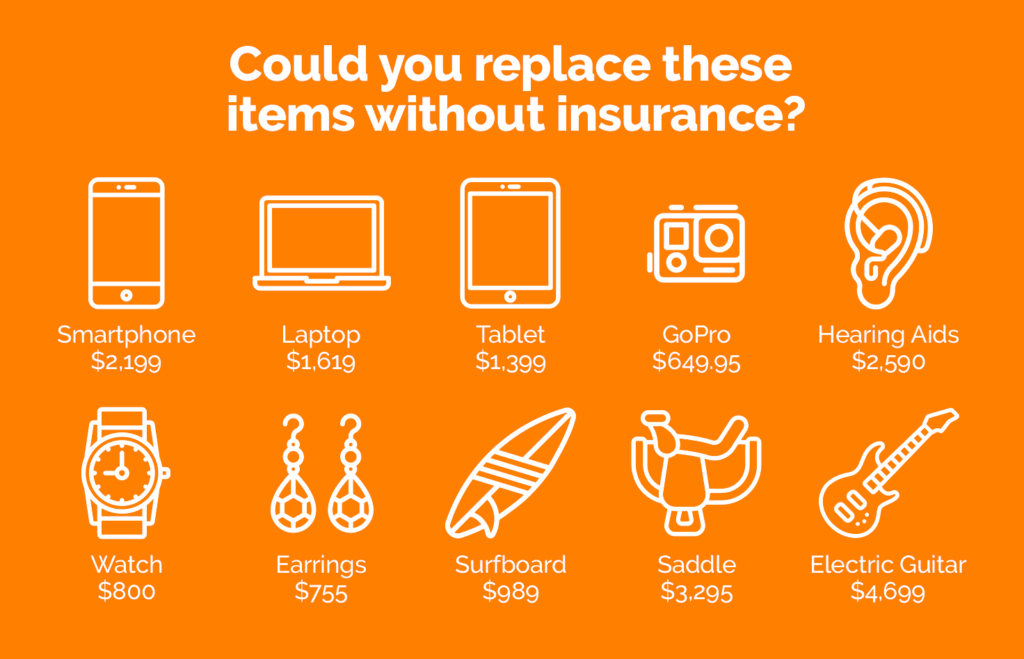Portable Contents & Personal Effects Insurance
Portable Contents & Personal Effects Insurance
*iSelect does not compare to all home and contents insurers in the market. The availability of policies may change from time to time. Not all policies made available from iSelect’s providers are compared by iSelect and due to commercial arrangements, area or availability, not all policies compared by iSelect will be available to all customers. See below for our range of home and contents insurers. Some policies are only available from iSelect’s call centre or online. Our advice on this website is of general nature and does not consider your situation or needs. Consider if any advice is appropriate for you before acting on it. Learn more.
Compare home and contents insurance the easy way*
Save time and effort by comparing a range of home and contents insurance policies with iSelect
What is Portable Contents Insurance?
What does Portable Contents Insurance cover?
What isn’t covered by Portable Contents Insurance?
How much does Portable Contents Insurance cost?
What might be worth considering when comparing Portable Contents Insurance Policies?
What types of documents could I need when making a Portable Contents Insurance claim?
Where can I find and compare Home and Contents Insurance?
What is Portable Contents Insurance?
Portable Contents Insurance is for those valuables that get out and about in the world with us, from engagement rings and smart phones to laptops and hearing aids. Since your Contents Insurance protection ends when you leave your home, Portable Contents Insurance can help bridge the gap for those valuables that are part of your everyday, even if they’re travelling across the country with you or jet-setting around the world in your pocket.
You’ll typically see two types of Portable Contents Insurance on offer: unspecified and specified. With unspecified, you can cover a few different categories or groups of items up to a certain claim limit, such as $1,000 for all your jewellery. Specified, on the other hand, gives you a bit more control. You can list individual items with descriptions and nominated values on your policy. It can mean there’s no claim limit if you lose that antique watch, but it could also mean a higher premium than going with unspecified.
If you already have Home and Contents Insurance, Portable Contents Insurance could be an add-on for an extra premium. Alternatively, you may be able to get it as a standalone policy.
Helpful Tip
Sometimes you might see Portable Contents Insurance called other things, like Personal Effects Insurance, personal valuables cover or Single Item Insurance. No matter the name though, the general aim of the cover is the same.
What does Portable Contents Insurance cover?
While what’s covered can vary depending on whether you choose specified or unspecified Personal Effects Insurance, you may be able to insure against damage or loss for items like:
- Kids car seats and prams
- Handbags and briefcases
- Medical aids and glasses
- Jewellery, including engagement rings and watches
- Musical instruments
- Photography and videography equipment
Your Product Disclosure Statement (PDS) could give you a clearer idea of what your policy covers.
Something you may want to keep in mind though is that you likely will need to keep your insured items in good nick to have them covered.
Additionally, while your Home and Contents Policy will adjust for changing repair and replacement costs, your Personal Effects Insurance may not. So, it might be a good idea to regularly review what you’re insuring and for how much. Luckily, it’s pretty straightforward to add or remove items from an existing policy. Depending on your insurer, it may be as simple as making a phone call or using an online portal.
What isn’t covered by Portable Contents Insurance?
As with inclusions, exclusions can vary between policies. However, you might want to steel yourself to see any items used for business, including phones or laptops, on the exclusions list. When it comes to events, you’ll probably see accidents, wear and tear, fire, and rain damage on the list too. Additionally, if someone takes advantage of you leaving your laptop in your unlocked car or just nipping to the bathroom at a café with your phone left on the table, you probably won’t be covered either.
This is another one of those times where flicking through the PDS may not be such a bad idea. Keeping up with exclusions could help you avoid disappointment or be the motivation to find a policy that offers better value.
How much does Portable Contents Insurance cost?
Buying insurance isn’t like buying groceries. For a start, you’re not going to find your house suddenly overrun by tiny collectibles with every purchase. Additionally, there’s not really set prices for insurance. Your premium will depend on a range of factors, like if you choose specified or unspecified. Even your chosen excess can affect the premium. You could pick an excess as low as $100, but that might mean your premium is higher. Alternatively, you could go with a higher excess but risk not being able to pay the replacement difference leftover after a successful claim.

Sources: Samsung – Galaxy S24 Ultra, Microsoft – Surface Pro 9, Apple – Shop iPad, GoPro – All Cameras, Hearing Aid Australia – Oticon intent 4 miniRITE Rechargeable, Swarovski – Octea Chrono watch, Tiffany & Co. – Pearl Drop Earrings, The Surfboard Warehouse – Re-evolution by Beau Young Longboard – Caramel, Horseland – All Purpose + Saddle With Cair II, Fender – American Ultra Luxe Stratocaster
What might be worth considering when comparing Portable Contents Insurance Policies?
If you’re looking to set up a showdown between Personal Effects Insurance Policies, there’s a few considerations you could make to weigh up which is your winner.
- Premium: This is what you’re going to be paying regularly to keep your valuables insured and can change between policies and providers.
- Excess: You could have some flexibility in the excess you set — and it may even help lower your premium.
- Limits: Are you okay with the unspecified claim limits set by your insurer or would you prefer to set your own with specified insurance?
- Coverage: From what events and items are covered to how far you can travel from home before that cover disappears, this could be a real gamechanger for you.
- On-demand options: If you just want cover when you’re out, on-demand cover that only applies when you switch it on and leave the house might stand out for you.
What types of documents could I need when making a Portable Contents Insurance claim?
When it comes time to making a claim, we don’t blame you if you’re struggling to think clearly. But you could make it a little easier for yourself by ensuring you have two kinds of documents handy: proof of ownership and proof of value. After all, a successful claim tends to come down to confirming that you owned what got lost or damaged and that it was really worth that much.
For proof of ownership, things like purchase receipts or credit card statements are probably the most obvious. You could also provide proof through showing you have the owner’s manual or warranty certificate, photos or videos of the item in your possession, records of the item’s serial number or even the packaging from it.
Purchase receipts and credit card statements could also function as evidence of the item’s value. But you could also bring out any valuations you’ve had done, like for an antique or heirloom piece.
Where can I find and compare Home and Contents Insurance?
Whether you’re looking for an upgrade or your first Home and Contents Insurance Policy, iSelect can help. With our online comparison tool, you can check out a selection of Home and Contents Insurance options, including Portable Contents Insurance add-ons, in a matter of minutes.* Alternatively, you can call 13 19 20 to speak to one of our comparison experts.

.svg)






